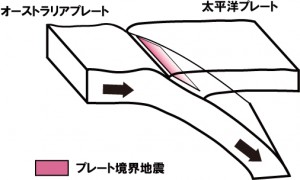According to USGS, a M7.8 earthquake occurred at 7:03am, October 8th, 2009 (Japan time. 9:03am, local time) near Vanuatu in the South Pacific Ocean (13.052°S, 166.187°E, 35km deep). 15 minutes later, 60km north, a M7.7 earthquake occurred near the Santa Cruz Islands (12.554°S, 166.320°E)
Tsunamis were observed close to the epicenter, due to the large magnitude and shallow epicenter. JMA had released information on the tsunamis in the northwest Pacific Ocean but was canceled later.
Following is the information on the earthquake. (Outreach Office)
[Updated]
- Waveforms observed by J-array (Oct 9)
- Tectonics Background (Oct8)
- Links
[Answers to Frequently Asked Questions]
- the M7.8 earthquake and the M7.7 earthquake 15 minutes later are considered as an “earthquake doublet”
- the M7.7 (by USGS) earthquake an hour later of these is considered to be the aftershock of the first earthquake
- it is unlikely to think og the relevance between the earthquakes ad Samoa and Sumatra which occurred within this week
- it is considered as an interplate earthquake that occurred at the boundary of the Australian plate subducting beneath the Pacific plate
[Tectonics Background ]
Vanuatu and the Solomon Islands are located on the boundary of the Australian plate and the Pacific plate. The Australian plate is sliding 91mm/year northeast with respect to the Pacific plate. This earthquake has a reverse fault mechanism with a compression axis towards the subduction and is considered that the earthquake occurred on the boundary of the subducting plate.
The earthquake that occurred 15 minutes later, about 50km north at the Santa Cruz Islands has a similar reverse fault mechanism at the plate boundary. It is considered as an “earthquake doublet” from the subequal size of the magnitude and the similar mechanism.
It is a known fact that the doublets are often observed in this region. The recent doublet occurred on April 21st, 1997, with a magnitude of 7.
There were also a M7.2 earthquake in 2007, and a M7.3 earthquake in 1999, and a tsunami was observed in the 1999 earthquake, but the residents evacuated uphill and were no victims.
[Waveforms Observed by J-array]
The new J-array earthquake waveform database uses the network to resemble a giant array and collects the seismogram realtime from all over the world and is put int o the database. At the moment, all three components of the waveform data from about 400 stations placed by universities and the JMA are collected through the high-speed ground network. Seismogram is sampled in 20Hz. transformed into and saved as J-array Standard Waveform Data.
